The butynediol synthesis catalyst market is valued at USD 98.1 million in 2025 and is projected to reach USD 259.1 million by 2035, representing a robust CAGR of 10.2%. This growth reflects rising demand for high-performance polymers, biodegradable plastics, and synthetic fibers, where Butynediol plays a crucial role as a feedstock. The market shows consistent annual expansion, reaching USD 108.1 million in 2026, USD 119.1 million in 2027, and USD 131.3 million in 2028. These figures indicate stable year-on-year growth, driven by increased industrial production capacity, innovation in catalyst technology, and growing applications in the automotive and electronics sectors.
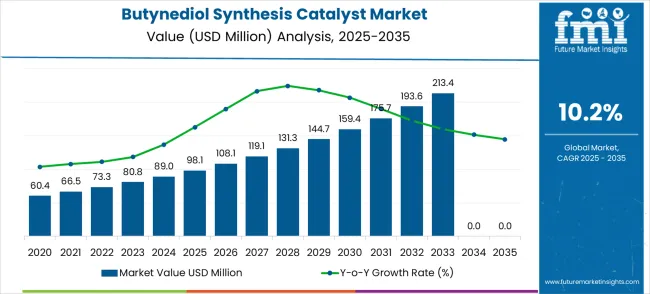
Short-term forecasting for the next three years suggests steady upward momentum. Based on historical year-on-year trends, the market is expected to reach USD 144.7 million by 2029, driven by demand from the polyurethanes and specialty chemicals sectors. The years 2026–2028 are expected to witness annual growth rates of between 9% and 10%, driven by expansions in Asia-Pacific manufacturing hubs and increasing adoption in emerging economies. Regulatory focus on eco-friendly chemicals and efficiency improvements in synthesis processes is expected to bolster short-term growth further.
| Metric | Value |
|---|---|
| Estimated Value in (2025E) | USD 98.1 million |
| Forecast Value in (2035F) | USD 259.1 million |
| Forecast CAGR (2025 to 2035) | 10.2% |
Long-term forecasting using CAGR and trend analysis indicates substantial market growth over the decade. The market is expected to surpass USD 193.6 million by 2032 and reach USD 259.1 million by 2035. The largest absolute gains are expected in the latter part of the forecast period, with increases such as USD 22 million between 2034 and 2035. This reflects not only continued expansion but also maturity in adoption, as Butynediol synthesis becomes more integrated across industrial production lines. Growth will be supported by innovations in catalyst efficiency and rising demand for eco-friendly chemical synthesis methods globally.
Scenario analysis for the market reveals distinct possibilities. In an optimistic scenario, driven by rapid technological adoption and accelerated sustainability regulations, the CAGR could increase to approximately 12%, pushing the market beyond USD 300 million by 2035. The base-case scenario, aligned with current forecasts, retains a CAGR of 10.2%, reaching USD 259.1 million by the decade’s end. In a pessimistic scenario, slower adoption due to supply chain disruptions or raw material shortages could reduce CAGR to near 8%, resulting in a market size closer to USD 210 million by 2035. The market shows strong long-term potential underpinned by technological advancements and growing sustainability trends.
Market expansion is being supported by the increasing global demand for specialty chemical intermediates and the corresponding need for advanced catalytic systems that can provide superior synthesis efficiency and high selectivity while maintaining process reliability across various chemical manufacturing and polymer production applications. Modern chemical manufacturers are increasingly focused on implementing catalytic solutions that can maximize conversion rates, enable complex molecular transformations, and provide consistent performance in demanding industrial environments. Butynediol synthesis catalysts' proven ability to deliver superior synthesis efficiency, enhanced selectivity, and reliable catalytic performance make them essential components for contemporary specialty chemical manufacturing and advanced synthesis solutions.
The growing focus on value-added chemical production and process intensification is driving demand for butynediol synthesis catalysts that can support complex synthesis pathways, enable efficient intermediate production, and provide reliable performance in multi-step chemical processes with minimal by-product formation. Chemical processing companies' preference for catalysts that combine high performance with operational flexibility and economic viability is creating opportunities for innovative butynediol synthesis catalyst implementations. The rising influence of sustainable chemistry and green manufacturing trends is also contributing to increased adoption of catalysts that can provide advanced synthesis solutions without compromising process efficiency or environmental compliance.
The market is segmented by classification, application, and region. By classification, the market is divided into copper catalyst and nickel catalyst. Based on application, the market is categorized into tetrahydrofuran (THF), polybutylene terephthalate (PBT), γ-butyrolactone (GBL), polyurethane (PU), and others. Regionally, the market is divided into North America, Europe, East Asia, South Asia & Pacific, Latin America, and the Middle East & Africa.
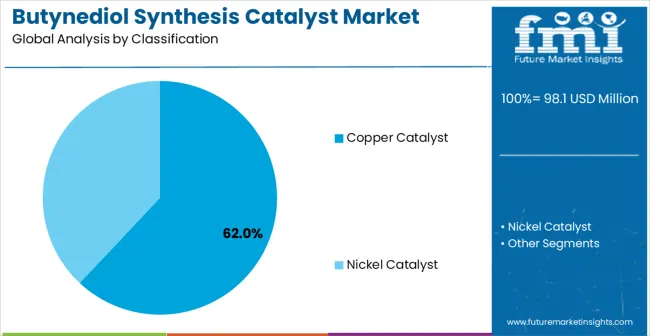
The copper catalyst segment is projected to account for 62.0% of the butynediol synthesis catalyst market in 2025, reaffirming its position as the leading classification category. Chemical manufacturers increasingly utilize copper catalysts for their superior catalytic activity, proven synthesis efficiency, and convenience in butynediol synthesis applications across specialty chemical production, polymer manufacturing, and chemical intermediate synthesis operations. Copper catalyst technology's established synthesis capabilities and consistent performance output directly address the industrial requirements for reliable chemical synthesis and operational efficiency in complex molecular transformation processes.
This classification segment forms the foundation of modern butynediol synthesis operations, as it represents the catalyst type with the greatest application versatility and established market demand across multiple chemical manufacturing categories and synthesis requirements. Chemical plant investments in enhanced copper catalyst technologies and process optimization continue to strengthen adoption among specialty chemical producers. With manufacturers prioritizing consistent performance and proven synthesis reliability, copper catalysts align with both operational efficiency objectives and quality requirements, making them the central component of comprehensive butynediol synthesis strategies.
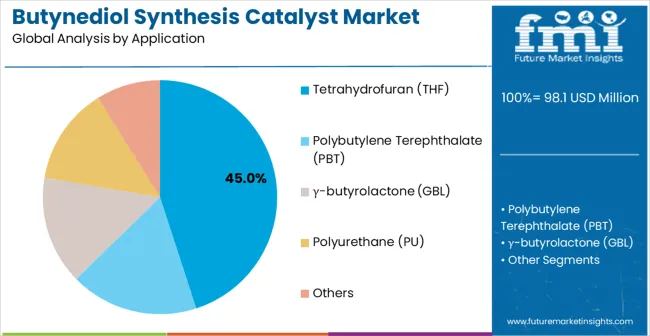
Tetrahydrofuran (THF) applications are projected to represent 45.0% of butynediol synthesis catalyst demand in 2025, highlighting their critical role as the primary application market for specialty chemical catalysts in THF production and solvent manufacturing facilities. THF manufacturers prefer butynediol synthesis catalysts for their exceptional conversion efficiency, superior selectivity performance, and ability to produce high-quality chemical intermediates while maintaining process reliability and cost-effectiveness. Positioned as essential catalysts for modern THF production pathways, butynediol synthesis catalysts offer both performance advantages and economic benefits.
The segment is supported by continuous growth in THF demand and the growing availability of specialized catalyst technologies that enable efficient intermediate synthesis with enhanced conversion rates and improved process economics. THF manufacturers are investing in advanced catalyst systems to support high-volume production and quality assurance for demanding solvent and polymer applications. As THF consumption continues to grow and synthesis requirements increase, THF applications will continue to dominate the end-user market while supporting advanced catalyst utilization and specialty chemical production strategies.
The butynediol synthesis catalyst market is advancing rapidly due to increasing demand for specialty chemical intermediates and growing adoption of advanced synthesis technologies that provide enhanced conversion efficiency and superior selectivity across diverse chemical manufacturing and polymer production applications. The market faces challenges, including complex synthesis requirements, technical expertise needs, and the need for specialized process equipment investments. Innovation in catalyst regeneration and process optimization continues to influence product development and market expansion patterns.
The growing adoption of nickel catalyst formulations and enhanced support systems is enabling chemical catalyst manufacturers to produce premium butynediol synthesis catalysts with superior conversion rates, enhanced selectivity characteristics, and advanced operational stability. Advanced catalyst systems provide improved chemical performance while allowing more efficient processing and consistent output across various synthesis conditions and feedstock compositions. Manufacturers are increasingly recognizing the competitive advantages of advanced catalyst capabilities for product differentiation and premium market positioning in demanding specialty chemical segments.
Modern butynediol synthesis catalyst producers are incorporating process optimization technologies and green chemistry principles to enhance catalyst performance, improve synthesis efficiency, and ensure consistent delivery to chemical manufacturers and processing facilities. These technologies improve manufacturing sustainability while enabling new applications, including reduced-waste processes and environmentally friendly synthesis methods. Advanced sustainability integration also allows manufacturers to support premium positioning and environmental responsibility beyond traditional catalyst production capabilities.
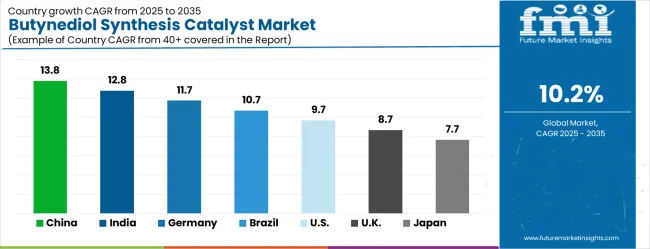
| Country | CAGR (2025-2035) |
|---|---|
| China | 13.8% |
| India | 12.8% |
| Germany | 11.7% |
| Brazil | 10.7% |
| USA | 9.7% |
| UK | 8.7% |
| Japan | 7.7% |
The market is experiencing exceptional growth globally, with China leading at a 13.8% CAGR through 2035, driven by the expanding chemical manufacturing industry, growing specialty chemical production capacity, and significant investment in advanced catalyst technology infrastructure development. India follows at 12.8%, supported by large-scale chemical industry expansion, emerging catalyst manufacturing facilities, and growing domestic demand for specialty chemical production technologies. Germany shows growth at 11.7%, focusing technological innovation and advanced catalyst development. Brazil records 10.7%, focusing on chemical industry expansion. The USA demonstrates 9.7% growth, prioritizing advanced chemical technologies and high-performance catalyst solutions. The UK exhibits 8.7% growth, focusing chemical manufacturing capabilities and specialty catalyst adoption. Japan shows 7.7% growth, supported by precision chemical manufacturing excellence and advanced catalyst technology innovation.
The report covers an in-depth analysis of 40+ countries; top-performing countries are highlighted below.
China is forecasted to expand at a CAGR of 13.8% during 2025–2035, driven by growing demand in polymer production, pharmaceutical intermediates, and specialty chemical manufacturing. Butynediol synthesis catalysts are critical in the production of high-value intermediates such as tetrahydrofuran, 1,4-butanediol, and other derivatives. Domestic manufacturers are focusing on high-efficiency catalyst designs, cost-effective production techniques, and process optimization to meet demand. Growth is supported by expansion in the automotive and electronics sectors, as well as increasing exports of intermediate chemicals. Strategic collaborations between catalyst suppliers and chemical manufacturers ensure technology transfer and enhanced production efficiency. Rising R&D investments and government support for advanced chemical manufacturing are also driving catalyst adoption, positioning China as a major player in global butynediol synthesis catalyst production.
India is projected to grow at a CAGR of 12.8% between 2025 and 2035, supported by expansion in the chemical processing, pharmaceutical, and polymer manufacturing industries. Butynediol synthesis catalysts are increasingly used for the production of solvents, polyurethanes, and biodegradable plastics. Local manufacturers focus on catalyst efficiency and cost optimization. Growth is supported by rising domestic demand for high-performance polymers, pharmaceutical intermediates, and automotive applications. Government initiatives to boost the chemical manufacturing sector, promote technology adoption, and reduce dependence on imports are further strengthening the market. Collaborations with global catalyst suppliers are enhancing process performance and reducing production costs, thereby driving demand for high-efficiency butynediol catalysts in India.
Germany is expected to grow at a CAGR of 11.7% during 2025–2035, driven by its strong chemical and polymer manufacturing base. Butynediol synthesis catalysts are vital for producing high-performance polymers, solvents, and engineering materials used in automotive, electronics, and construction industries. German manufacturers emphasize catalyst purity, efficiency, and environmental compliance in production processes. Demand is fueled by the automotive industry’s adoption of advanced polymers, as well as growth in electronics manufacturing. Collaborations with European research institutions accelerate innovations in catalyst design, enabling improved performance and lower energy consumption. Germany’s leadership in green chemical manufacturing ensures robust adoption of next-generation butynediol catalysts in diverse industrial applications.
Brazil is projected to grow at a CAGR of 10.7% from 2025 to 2035, supported by demand from polymer production, chemical intermediates, and pharmaceutical sectors. Butynediol synthesis catalysts are critical in producing high-quality tetrahydrofuran, polybutylene terephthalate, and other intermediates. Local manufacturers focus on cost-efficient production processes, while importing high-performance catalysts for specialized applications. Growth is fueled by the expansion of automotive manufacturing, packaging, and polymer production for domestic and export markets. Government initiatives promoting chemical production efficiency and environmental compliance further encourage adoption. Strategic partnerships with global catalyst producers ensure access to advanced technology and improved production yields.
The United States is expected to grow at a CAGR of 9.7% from 2025 to 2035, driven by demand in polymer production, specialty chemicals, and pharmaceutical intermediates. Butynediol synthesis catalysts are critical for producing high-value polymers such as polyurethanes and engineering plastics. Manufacturers focus on high-efficiency catalysts, automation integration, and green production processes. Growth is supported by demand in automotive components, flexible packaging, and electronics. Stricter environmental regulations and consumer preference for eco-friendly production encourage the adoption of advanced catalysts. Collaborations with European and Asian catalyst suppliers improve access to innovative technologies and reduce operational costs, reinforcing the competitive advantage of USA manufacturers in high-value chemical production.
The United Kingdom is forecasted to grow at a CAGR of 8.7% during 2025–2035, driven by demand in chemical manufacturing, polymer production, and specialty applications. Butynediol synthesis catalysts are increasingly used in producing high-quality solvents, engineering plastics, and biodegradable polymers. UK manufacturers are focusing on process optimization, catalyst efficiency, and cost reduction to remain competitive. Growth is supported by expanding automotive and packaging sectors, as well as rising demand for eco-friendly materials. Collaborations with international catalyst suppliers ensure access to high-performance catalysts and advanced production technologies. Regulatory focus on environmental compliance reinforces the adoption of sustainable catalysts across the UK chemical industry.
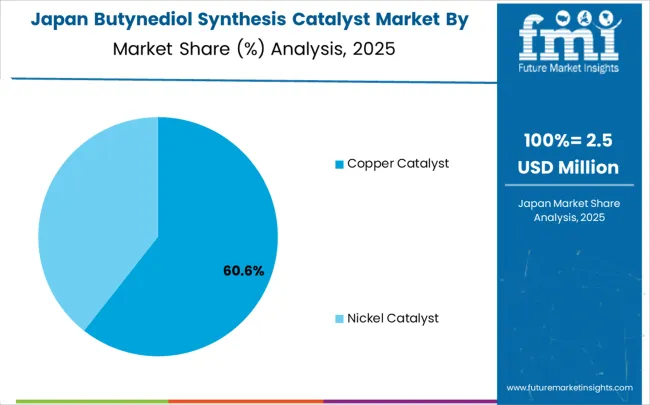
Japan is projected to grow at a CAGR of 7.7% between 2025 and 2035, driven by demand in polymer production, automotive manufacturing, and electronics. Butynediol synthesis catalysts are essential for producing high-performance engineering plastics and solvents. Japanese manufacturers focus on high-purity catalyst production, energy-efficient processes, and precision engineering. Growth is supported by the automotive sector’s demand for durable polymer components, expansion of electronics manufacturing, and the adoption of biodegradable materials. Collaborative R&D with European and Asian catalyst developers further strengthens innovation and efficiency. Strict environmental standards and export-oriented production enhance catalyst adoption, positioning Japan as a strategic player in the global butynediol synthesis catalyst market.
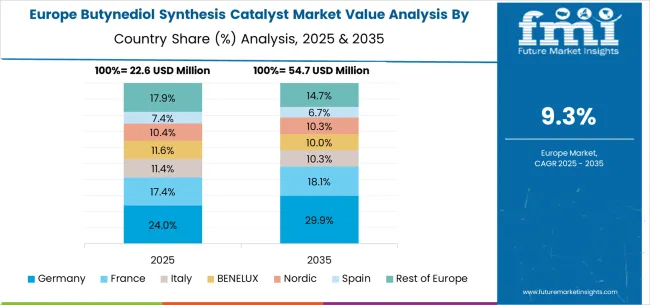
The butynediol synthesis catalyst market in Europe is projected to grow from USD 21.6 million in 2025 to USD 57.0 million by 2035, registering a CAGR of 10.2% over the forecast period. Germany is expected to maintain its leadership position with a 25.0% market share in 2025, declining slightly to 24.5% by 2035, supported by its strong chemical manufacturing industry, advanced catalyst production facilities, and comprehensive specialty chemical supply network serving major European markets.
France follows with an 18.0% share in 2025, projected to reach 18.3% by 2035, driven by robust demand for butynediol synthesis catalysts in chemical manufacturing, polymer production, and specialty chemical applications, combined with established chemical traditions incorporating advanced catalyst technologies. The United Kingdom holds a 16.5% share in 2025, expected to decrease to 16.2% by 2035, supported by strong chemical sector demand but facing challenges from competitive pressures and industrial restructuring. Italy commands a 14.0% share in 2025, projected to reach 14.2% by 2035, while Spain accounts for 12.0% in 2025, expected to reach 12.2% by 2035. The Netherlands maintains a 4.0% share in 2025, growing to 4.2% by 2035. The Rest of Europe region, including Nordic countries, Eastern Europe, Portugal, Belgium, Switzerland, and Austria, is anticipated to gain momentum, expanding its collective share from 10.5% to 10.6% by 2035, attributed to increasing adoption of specialty chemical technologies in Nordic countries and growing catalyst manufacturing activities across Eastern European markets implementing advanced chemistry modernization programs.
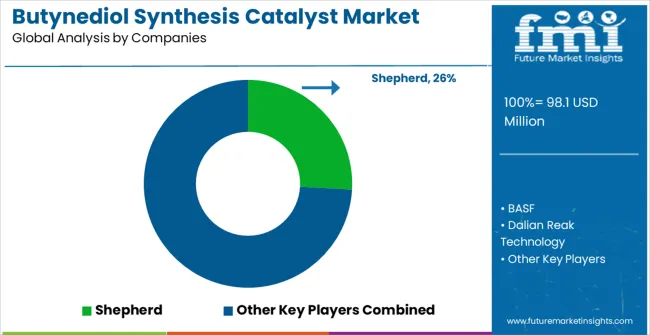
The butynediol synthesis catalyst market is characterized by competition among established chemical catalyst manufacturers, specialized synthesis technology suppliers, and integrated specialty chemical solution providers. Companies are investing in advanced catalyst technology research, synthesis optimization, process development, and comprehensive product portfolios to deliver consistent, high-quality, and cost-effective butynediol synthesis catalyst solutions. Innovation in catalyst formulations, process integration, and green manufacturing is central to strengthening market position and competitive advantage.
Shepherd leads the market with a strong market share, offering comprehensive catalyst solutions with a focus on specialty chemical applications and advanced synthesis systems. BASF provides specialized catalyst capabilities with an focus on chemical processing and manufacturing efficiency. Dalian Reak Technology delivers innovative catalyst solutions with a focus on Asian markets and synthesis technology. Sunchem specializes in catalyst manufacturing and advanced chemical solutions for specialty markets. Hunan Yussen Energy Technology focuses on catalyst technology and integrated synthesis operations.
| Items | Values |
|---|---|
| Quantitative Units (2025) | USD 98.1 million |
| Classification | Copper Catalyst, Nickel Catalyst |
| Application | Tetrahydrofuran (THF), Polybutylene Terephthalate (PBT), γ-butyrolactone (GBL), Polyurethane (PU), Others |
| Regions Covered | North America, Europe, East Asia, South Asia & Pacific, Latin America, Middle East & Africa |
| Countries Covered | United States, Canada, United Kingdom, Germany, France, China, Japan, South Korea, India, Brazil, Australia and 40+ countries |
| Key Companies Profiled | Shepherd, BASF, Dalian Reak Technology, Sunchem, and Hunan Yussen Energy Technology |
| Additional Attributes | Dollar sales by classification and application category, regional demand trends, competitive landscape, technological advancements in catalyst systems, synthesis innovation, process development, and manufacturing optimization |
North America
Europe
East Asia
South Asia & Pacific
Latin America
Middle East & Africa
The global butynediol synthesis catalyst market is estimated to be valued at USD 98.1 million in 2025.
The market size for the butynediol synthesis catalyst market is projected to reach USD 259.1 million by 2035.
The butynediol synthesis catalyst market is expected to grow at a 10.2% CAGR between 2025 and 2035.
The key product types in butynediol synthesis catalyst market are copper catalyst and nickel catalyst.
In terms of application, tetrahydrofuran (thf) segment to command 45.0% share in the butynediol synthesis catalyst market in 2025.






Our Research Products

The "Full Research Suite" delivers actionable market intel, deep dives on markets or technologies, so clients act faster, cut risk, and unlock growth.

The Leaderboard benchmarks and ranks top vendors, classifying them as Established Leaders, Leading Challengers, or Disruptors & Challengers.

Locates where complements amplify value and substitutes erode it, forecasting net impact by horizon

We deliver granular, decision-grade intel: market sizing, 5-year forecasts, pricing, adoption, usage, revenue, and operational KPIs—plus competitor tracking, regulation, and value chains—across 60 countries broadly.

Spot the shifts before they hit your P&L. We track inflection points, adoption curves, pricing moves, and ecosystem plays to show where demand is heading, why it is changing, and what to do next across high-growth markets and disruptive tech

Real-time reads of user behavior. We track shifting priorities, perceptions of today’s and next-gen services, and provider experience, then pace how fast tech moves from trial to adoption, blending buyer, consumer, and channel inputs with social signals (#WhySwitch, #UX).

Partner with our analyst team to build a custom report designed around your business priorities. From analysing market trends to assessing competitors or crafting bespoke datasets, we tailor insights to your needs.
Supplier Intelligence
Discovery & Profiling
Capacity & Footprint
Performance & Risk
Compliance & Governance
Commercial Readiness
Who Supplies Whom
Scorecards & Shortlists
Playbooks & Docs
Category Intelligence
Definition & Scope
Demand & Use Cases
Cost Drivers
Market Structure
Supply Chain Map
Trade & Policy
Operating Norms
Deliverables
Buyer Intelligence
Account Basics
Spend & Scope
Procurement Model
Vendor Requirements
Terms & Policies
Entry Strategy
Pain Points & Triggers
Outputs
Pricing Analysis
Benchmarks
Trends
Should-Cost
Indexation
Landed Cost
Commercial Terms
Deliverables
Brand Analysis
Positioning & Value Prop
Share & Presence
Customer Evidence
Go-to-Market
Digital & Reputation
Compliance & Trust
KPIs & Gaps
Outputs
Full Research Suite comprises of:
Market outlook & trends analysis
Interviews & case studies
Strategic recommendations
Vendor profiles & capabilities analysis
5-year forecasts
8 regions and 60+ country-level data splits
Market segment data splits
12 months of continuous data updates
DELIVERED AS:
PDF EXCEL ONLINE
BDO Synthesis Catalyst Market Size and Share Forecast Outlook 2025 to 2035
Catalyst Bins Market Insights – Growth & Forecast 2025 to 2035
Biocatalyst Market Size and Share Forecast Outlook 2025 to 2035
Nanocatalysts Market Size and Share Forecast Outlook 2025 to 2035
DNA Synthesis Market Growth - Trends & Forecast 2025 to 2035
Radiosynthesis Equipment Market Size and Share Forecast Outlook 2025 to 2035
Gene Synthesis Market Growth – Trends & Forecast 2025 to 2035
cDNA Synthesis Market
Peptide Synthesis Market Analysis – Trends, Share & Growth 2025 to 2035
Titanium Catalyst for Polyester Market Size and Share Forecast Outlook 2025 to 2035
Chemical Catalyst Market Size and Share Forecast Outlook 2025 to 2035
Refinery Catalyst Market Growth - Trends & Forecast 2025 to 2035
Polyolefin Catalyst Market Size and Share Forecast Outlook 2025 to 2035
Spinal Osteosynthesis Units Market Trends – Industry Forecast 2025 to 2035
UK Refinery Catalyst Market Insights – Growth, Applications & Outlook 2025-2035
Polyurethane Catalyst Market Size and Share Forecast Outlook 2025 to 2035
USA Refinery Catalyst Market Report - Trends & Innovations 2025 to 2035
Enzymatic DNA Synthesis Market Size and Share Forecast Outlook 2025 to 2035
Environmental Catalysts Market Trends & Growth 2025 to 2035
Custom Peptide Synthesis Services Market Size and Share Forecast Outlook 2025 to 2035

Thank you!
You will receive an email from our Business Development Manager. Please be sure to check your SPAM/JUNK folder too.
Chat With
MaRIA